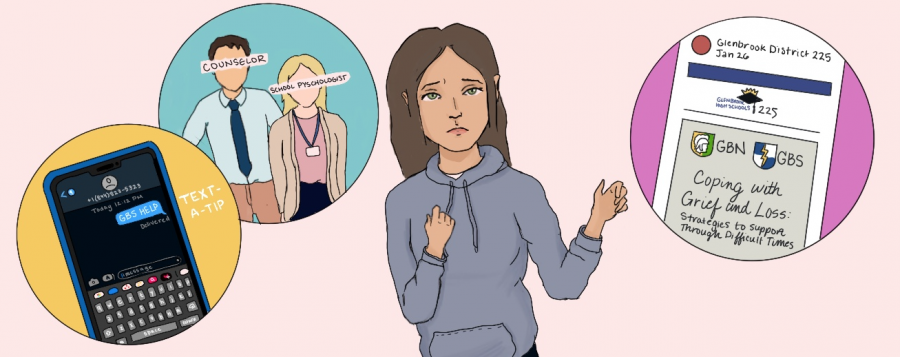Glenbrook administration must reevaluate mental health approach
February 12, 2021
In a year filled with immense stress, District 225 has taken commendable steps to prioritize the mental health of its students. The “Do No Harm” policy enacted before first Semester final exams in the wake of tragedy and less-than-ideal learning conditions was a clear example of putting students’ well-being first.
However, a single proactive action is not enough—nearly 50 percent of children with a mental health disorder do not receive the professional help they need, according to the American Academy of Family Physicians.
That number needs to change.
Junior Casey Kraabel said that a fear of seeking help is not uncommon. Asking for help is often daunting, Kraabel said, especially when the following reaction is unknown.
Reaching out for help is even more difficult for students whose mental health struggles are not validated at home, a battle 20 percent of South students face, according to an unscientific survey conducted by The Oracle of 500 students.
“You never know what someone is going to say,” Kraabel said. “If you’re going to ask a teacher or counselor and they’re not helpful, you kind of just gave yourself away and now you feel vulnerable. I know that’s a big factor in why people keep things inside.”
Currently, South approaches students’ mental health by promoting an anonymous text hotline, known as “Text-a-Tip,” with a certified mental health professional; urging students to reach out to teachers and counselors when necessary; including mental health curriculum in health and PE classes; and offering grieving services when necessary.
The Editorial Board commends South’s commitment to prioritizing students’ mental health; however, the current strategy of waiting for students to reach out is not proactive. With South’s current approach, the pressure currently lies on the struggling student to take the intimidating first step of asking for help.
The Oracle Editorial Board urges the administration, teachers and counselors to take a more proactive approach towards students’ mental health by initiating periodic check-ins and reaching out to students they suspect are struggling. These check-ins may include sending out monthly mental health Google Forms, asking about missing assignments before entering grades and watching for signs that a student may be struggling.
Spanish Teacher Anne Walsh prioritizes checking in with her students in multiple ways. For example, one-word whip-arounds answering the question “How are you?” and meditation are commonplace in her classroom. Doing so offers her a glimpse into what may be going on in her students’ worlds and affairs.
“[After doing an activity asking the students how they were], to see 30 responses of distress at one time made me [change class plans] to ‘choice time,’” Walsh said. “It allowed me to check in on them. Also in Peardeck, [an interactive teaching tool], I can see that a person is not working as much as normal [which usually means] that they’re upset. I know that there’s something going on.’”
Social Worker David Hartman explained that teachers and support staff are trained to look for warning signs in students who may be struggling. 47 percent of South students report an increased struggle with mental health since the onset of Covid-19, it is imperative these warning signs are caught early.
“Teachers are trained to look for any ‘different’ behaviors, [including] irritability, isolation, not participating, not handing in work, etc.” Hartman said. “Any change [in behavior] is a concern and should be reported to Student Services teams and home.”
Staff and faculty members should be wary of these signs and initiate contact with students who are displaying them. In most cases, teachers are the staff members that work the closest with students, and are the most likely to pick up on changing behaviors.
Junior Rachel Smith, founder and leader of Elpida, a club dedicated to promoting mental health, is proud of the resources South offers, though she wishes they were encouraged more, and she finds that teacher-student connection is also very important.
“I like when teachers do little surveys of wellness checks, asking ‘How are you? Is there anything I can do to accommodate your needs or adjust the class to make it better?,’” Smith said. “I think those surveys are such an important thing.”
The Editorial Board acknowledges that teachers and administrators are not trained mental health professionals; however, South employs five psychologists and six social workers who Hartman said can help students bridge the gap and access professional help. Kraabel finds that teachers working in tandem with Student Services provide the best support system.
“I try to tell [teachers] as much as I can, but it’s hard even for me to understand what’s going on and what to do,” Kraabel said. “A trained and certified psychiatrist is the best for these situations.” School Psychologist Dr. Kimberly Larsen explained that once contact is made between a teacher and a student requiring mental health assistance, the teacher reaches out to the student’s guidance counselor.
The guidance counselor then works with their team, which includes a psychologist and a social worker, one of whom schedules a session to talk to the student. The team often works with outside mental health providers as well, Larsen added.
For students who are able, asking for help—no matter how small the concern—is strongly encouraged. Text-a-Tip, the Titan Concern Line and talking to adults in the building are all avenues for students to get support.
However, in order for all students in need to receive support, not just those able to take the initial step, a proactive strategy of reaching out to students first is not only encouraged, but necessary.



